Exploring the Impact: How Neural Networks Are Redefining Vision Technology
In the ever-evolving landscape of technology, neural networks have emerged as a cornerstone in advancing vision technology. This transformation is not merely a leap but a redefinition of how machines interpret and understand visual data. The implications of this are vast, touching everything from healthcare diagnostics to vehicle automation.
The Mechanism Behind the Change
Neural networks mimic the human brain, particularly those designed for image recognition. They consist of layers of nodes, or neurons, each designed to recognize different aspects of visual data. The initial layers may detect simple features like edges and colors, while deeper layers can identify more complex textures and shapes. This hierarchical processing allows neural networks to interpret visual information in a profoundly sophisticated way.
Advancements in Healthcare
One of the most significant impacts of neural networks in vision technology can be seen in the healthcare industry. Diagnostic procedures that once relied heavily on the subjective judgment of human specialists are now being enhanced with the objective precision of machine learning. For example, neural networks are used in imaging tools to detect early signs of diseases like cancer more accurately and swiftly than ever. This capability not only improves the chances for successful treatment but also significantly reduces the waiting period for patients.
Revolutionizing Automotive Safety
The automotive sector has also benefitted immensely from advancements in neural network technology. Modern vehicles with advanced driver-assistance systems (ADAS) utilize these networks to process and interpret road scenarios in real-time. From recognizing traffic signs to detecting pedestrians, neural networks enhance the safety features of vehicles, leading to smarter, safer driving experiences. This technology is pivotal as we move towards fully autonomous driving, promising a future where road accidents are significantly reduced.
Impact on Surveillance and Security
Security systems powered by neural networks transform how surveillance is conducted. By analyzing real-time video feeds, these systems can detect unusual activities and potential threats more accurately and quickly than traditional methods. This capability is crucial in preventing crimes and ensuring public safety, making neural networks indispensable in modern security infrastructure.
Future Prospects: Beyond the Horizon
The potential of neural networks in vision technology is not confined to current applications. As these networks become more sophisticated, their ability to interact with and interpret the environment will lead to innovations we can only begin to imagine. Future applications might include more interactive and intuitive interfaces between humans and machines, further blurring the lines between digital and physical worlds.
In Conclusion
The role of neural networks in redefining vision technology is profound and far-reaching. As we continue to harness and refine this powerful tool, its impact across various sectors—healthcare, automotive, security, and beyond—is set to grow, reshaping our world in ways we are just starting to understand. The journey of neural networks in enhancing how machines see and interpret the world around us is just beginning, promising a future where technology and human vision converge seamlessly for a smarter, safer world.

